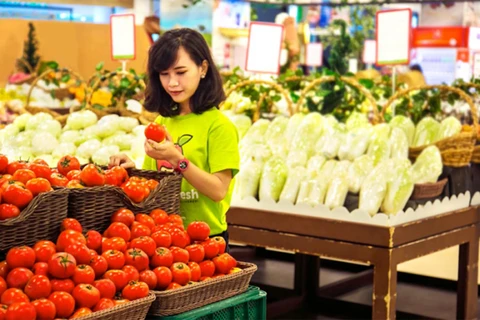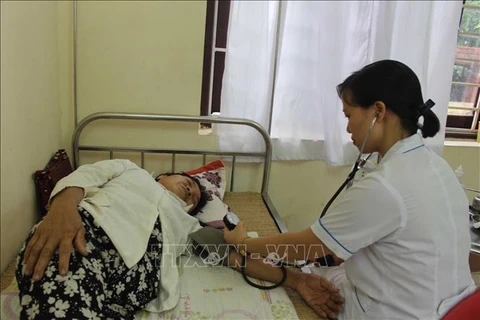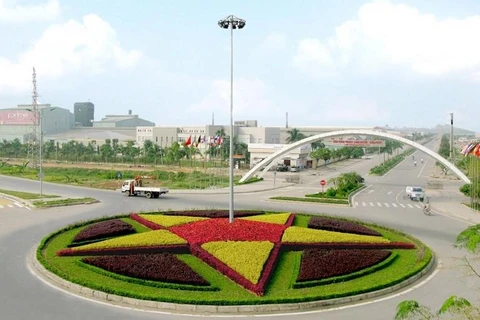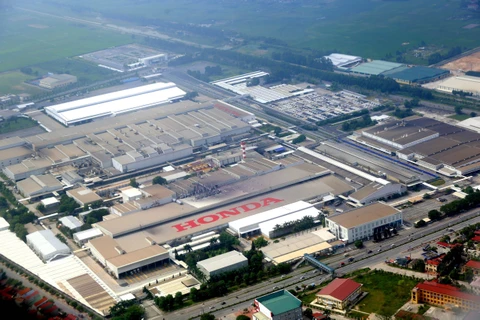Vinh Phuc (VNA) - Mechanisms and policies to support the local agro-forestry-fisheries sector have been broadly carried out around northern Vinh Phuc province since the beginning of the year, with a shift towards concentrated production based on value chains and market demand.
New technological advances are being applied effectively and infrastructure in service of agricultural production, especially irrigation systems, has been continually improved, raising the output of almost all major crops year-on-year.
Animal husbandry has been developing stably and the African swine fever was basically brought under control. Policies and mechanisms in support of agriculture restructuring, including animal husbandry, have been effectively implemented.
At the same time, prices for livestock products are relatively high, resulting in profits for local people and creating favourable conditions for production to develop.
In the first nine months of this year, poultry output rose over 7 percent, eggs more than 8 percent, and fresh cow milk over 36 percent, with annual growth of 3.47 percent recorded in animal husbandry.
Added value in the agro-forestry-fisheries sector reached 3.622 trillion VND (157.4 million USD) during the period, up 2.15 year-on-year, contributing 0.13 percentage point to the province’s growth.
As a developed industrial province, the land available for agriculture has been declining on an annual basis. In recent years, however, the economic value brought by the local agriculture sector has continued to grow. This stems from the province’s strategic vision to boost agricultural development to meet public demand, with hi-tech production models being a highlight in bringing in greater economic value.
High-tech agriculture has become more widespread in Vinh Phuc in recent times thanks to the undeniable benefits it provides.
Images of small, fragmented paddy fields are a thing of the past, replaced by expansive fields farmed by modern machinery. Farmers’ workloads have been cut, while the benefits heading their way are better than previously.
One example of change is Long Tri rice from Tam Duong district. Though well-known for a long period of time, Long Tri rice could not find its own place in the market because it had no trademark.
Only when the Long Tri rice cooperative was established and modern technology applied in production did its brand become better known and demand now exceed supply.
According to agriculture experts, the use of modern technology in production limits any waste of land and water resources and cuts the use of pesticides and chemical fertilisers. It also helps maintain the superiority of bio, gene, and organic technology and production automation.
With cost savings and increased productivity, production has become much more efficient, yielding high-quality products that meet demand.
A number of clean fruit and vegetable and herbal tree cultivation models in Vinh Phuc have reaped higher profits than conventional production methods.
Aware of this, the province has issued a number of policies and mechanisms to attract investors to hi-tech agriculture and meet growing consumer demand for safe and organic food.
Businesses have also been encouraged to build concentrated goods zones, while farmers have received instruction on how to grow short-time crops that meet VietGAP standards and bring high economic value.
Vinh Phuc has already established a number of concentrated production zones that meet VietGAP standards, as well as farm produce processing facilities and production-processing-consumption chains, thereby increasing the productivity and value of agricultural products and contributing to the sector’s growth.
The province is now home to over 1,300 farm produce processing facilities, from small to large. Since 2016, it has funded the purchase of nearly 2,000 pieces of agricultural machinery for farming households at a total cost of nearly 40 billion VND.
Amid global economic integration, demand for agricultural products has been constantly on the rise. Consumers in general and importers in particular, however, have high requirements in terms of quality, food safety and hygiene, sustainable development, and climate change.
There are major challenges facing the agriculture sector. The issues for hi-tech agriculture are primarily concerned with a lack of funding, investment, and preferential interest rates, detailed priority loans for hi-tech agriculture enterprises, and low market footholds that don’t encourage farmers to take an interest in safe cultivation.
In order to improve the efficiency of hi-tech agricultural production and therefore lay a foundation for sustainable agriculture development, Vinh Phuc will continue paying due regard to processing technology and post-harvest preservation to enhance production efficiency, diversify products, and encourage deep processing and the use of modern technology in production.
The province will also develop a support industry in service of agricultural production and mechanise all stages of the agricultural production value chain in a manner that suits conditions in each region and for each animal.
It will also deal with issues in production value chains, especially breeding technology, production and processing, and consumption.
Hi-tech agriculture will be developed to create breakthroughs in plant and animal productivity and quality, ensure food safety and hygiene, and improve competitiveness, while fully applying technical standards and processes in production and processing./.
New technological advances are being applied effectively and infrastructure in service of agricultural production, especially irrigation systems, has been continually improved, raising the output of almost all major crops year-on-year.
Animal husbandry has been developing stably and the African swine fever was basically brought under control. Policies and mechanisms in support of agriculture restructuring, including animal husbandry, have been effectively implemented.
At the same time, prices for livestock products are relatively high, resulting in profits for local people and creating favourable conditions for production to develop.
In the first nine months of this year, poultry output rose over 7 percent, eggs more than 8 percent, and fresh cow milk over 36 percent, with annual growth of 3.47 percent recorded in animal husbandry.
Added value in the agro-forestry-fisheries sector reached 3.622 trillion VND (157.4 million USD) during the period, up 2.15 year-on-year, contributing 0.13 percentage point to the province’s growth.
As a developed industrial province, the land available for agriculture has been declining on an annual basis. In recent years, however, the economic value brought by the local agriculture sector has continued to grow. This stems from the province’s strategic vision to boost agricultural development to meet public demand, with hi-tech production models being a highlight in bringing in greater economic value.
High-tech agriculture has become more widespread in Vinh Phuc in recent times thanks to the undeniable benefits it provides.
Images of small, fragmented paddy fields are a thing of the past, replaced by expansive fields farmed by modern machinery. Farmers’ workloads have been cut, while the benefits heading their way are better than previously.
One example of change is Long Tri rice from Tam Duong district. Though well-known for a long period of time, Long Tri rice could not find its own place in the market because it had no trademark.
Only when the Long Tri rice cooperative was established and modern technology applied in production did its brand become better known and demand now exceed supply.
According to agriculture experts, the use of modern technology in production limits any waste of land and water resources and cuts the use of pesticides and chemical fertilisers. It also helps maintain the superiority of bio, gene, and organic technology and production automation.
With cost savings and increased productivity, production has become much more efficient, yielding high-quality products that meet demand.
A number of clean fruit and vegetable and herbal tree cultivation models in Vinh Phuc have reaped higher profits than conventional production methods.
Aware of this, the province has issued a number of policies and mechanisms to attract investors to hi-tech agriculture and meet growing consumer demand for safe and organic food.
Businesses have also been encouraged to build concentrated goods zones, while farmers have received instruction on how to grow short-time crops that meet VietGAP standards and bring high economic value.
Vinh Phuc has already established a number of concentrated production zones that meet VietGAP standards, as well as farm produce processing facilities and production-processing-consumption chains, thereby increasing the productivity and value of agricultural products and contributing to the sector’s growth.
The province is now home to over 1,300 farm produce processing facilities, from small to large. Since 2016, it has funded the purchase of nearly 2,000 pieces of agricultural machinery for farming households at a total cost of nearly 40 billion VND.
Amid global economic integration, demand for agricultural products has been constantly on the rise. Consumers in general and importers in particular, however, have high requirements in terms of quality, food safety and hygiene, sustainable development, and climate change.
There are major challenges facing the agriculture sector. The issues for hi-tech agriculture are primarily concerned with a lack of funding, investment, and preferential interest rates, detailed priority loans for hi-tech agriculture enterprises, and low market footholds that don’t encourage farmers to take an interest in safe cultivation.
In order to improve the efficiency of hi-tech agricultural production and therefore lay a foundation for sustainable agriculture development, Vinh Phuc will continue paying due regard to processing technology and post-harvest preservation to enhance production efficiency, diversify products, and encourage deep processing and the use of modern technology in production.
The province will also develop a support industry in service of agricultural production and mechanise all stages of the agricultural production value chain in a manner that suits conditions in each region and for each animal.
It will also deal with issues in production value chains, especially breeding technology, production and processing, and consumption.
Hi-tech agriculture will be developed to create breakthroughs in plant and animal productivity and quality, ensure food safety and hygiene, and improve competitiveness, while fully applying technical standards and processes in production and processing./.
VNA
























